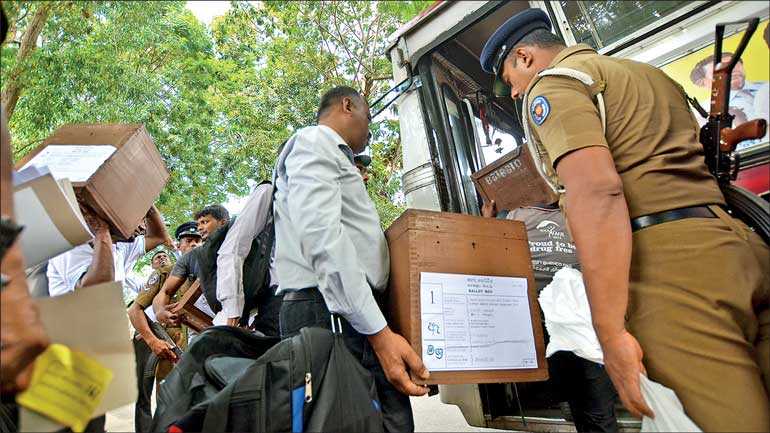Sunday Mar 16, 2025
Sunday Mar 16, 2025
Wednesday, 28 November 2018 00:00 - - {{hitsCtrl.values.hits}}

Does Sri Lanka have its own Florida and Ohio? Puttalam, Gampaha and Polonnaruwa would be the closest to being the swing districts of Sri Lanka. This is a study of the past 15 times the people of Sri Lanka voted in a major election or referendum.
I have taken the results of the presidential elections of 1982, 1988, 1994, 1999, 2005, 2010 and 2015 and the results of the general elections of 1989, 1994, 2000, 2001, 2004, 2010 and 2015 in addition to the referendum of 1982. Three districts in Sri Lanka have swung the right way 14 out of 15 times. These are Puttalam, Gampaha and Polonnaruwa Districts. The people of these three districts seem to know which way the country is voting and both major parties are strong in these districts. A study of these three districts can help political parties to win an election.
Puttalam District
Fourteen out of 15 times, Puttalam District has voted the way the national vote went. The only exception was in the presidential election of 2005, when the Puttalam District was won by Ranil Wickremesinghe but the election was won by Mahinda Rajapaksa. 
According to the 2012 census, the Puttalam District by ethnicity is 74% Sinhalese, with Moors making up over 19% and Tamils 6%. 43% of the people are Buddhist, 32% are Christian, 20% are Muslim and 4% are Hindus. This is a crucial district as it is allotted eight seats. Seven seats are contested under the proportional representation system and one bonus seat goes to the party which gets the largest number of votes.
As the Puttalam District is a swing district, the UNP and the SLFP have an equal base here. So it is always a neck-and-neck fight. Even if one of the parties gets the slightest edge over the other, it will win four out of seven seats and the bonus seat giving it five out of the eight seats and the losing side just three seats.
Puttalam is crucial because winning this district gives the winner two more seats in Parliament than the losing side. With no other major party other than the UNP and the SLFP having a foothold in this district, Puttalam District has seen a fierce rivalry between the UNP and the SLFP in the past decades with both sides equally strong in this district.
Gampaha District
The stronghold of the Bandaranaikes for decades, the Gampaha District is the second largest district by seats with 18 seats and is only second to Colombo which has 19 seats. The Gampaha District is right next to the Puttalam District. By ethnicity it is 90% Sinhalese. 70% are Buddhists, 20% Christian and Muslims and Hindus have less than 5% presence in this district.
The Gampaha District having nearly 8% of Parliamentary seats is a very important district which has helped the Bandaranaike family tilt the national vote in their favour for decades. In 2010, the Gampaha District’s UPFA campaign was directly led by Basil Rajapaksa who led the UPFA to a massive victory in the 2010 general elections where the UPFA got twice the votes of the UNP in the district. A lot of development was spearheaded by Basil Rajapaksa in the district.
In the 2015 presidential elections, Gampaha was lost by the UPFA but only by a razor-thin margin of 4,000 votes. Fourteen out of the 15 times there has been a national vote, Gampaha has voted the right way. The only exception was the presidential election of 1988, when Sirimavo Bandaranaike won the Gampaha District but President Ranasinghe Premadasa won the presidency. This is a crucial swing district and one which neither side can ignore.
Polonnaruwa District
The district of President Maithripala Sirisena, Polonnaruwa has voted with the national vote 14 out of 15 times, with the general elections of 2000 being the only exception. In 2000, the People’s Alliance won the general elections but Polonnaruwa was won by the UNP. With five seats in Parliament and no other major party having a foothold, the UNP and the SLFP fight it out among themselves for this district.
An interesting fact about this district is that it was MPs from the Polonnaruwa District who brought about the downfall of two SLFP governments. First was in 1964, when C.P. De Silva crossed over to the UNP bringing the SLFP-led Government to an end and the second time was 50 years later, when Maithripala Sirisena left the SLFP-led UPFA Government in 2014 and brought about its end. The Polonnaruwa District is 90% Sinhala Buddhist with 7% Muslims in the district. Polonnaruwa is another swing district which is important to both sides.
Swing States of America
Swing states have become important nowadays with few states or districts left undecided. If we look at America, back in 1984, President Ronald Reagan won 49 out of 50 states in America. Reagan was a Republican (same party as Donald Trump). President Johnson (Democrat) won 44 out of 50 states in 1964. Today, it would be beyond a miracle if a Republican can win Washington or New York or a Democrat winning that many states in the Bible belt of America.
In the last couple of decades, the central states of the US have become strongly Republican and the coastal US with the big cities has become Democratic strongholds. This led to America having swing states which are the only few states where both parties have an equal chance of winning and which end up winning the election for the parties.
Florida and Ohio are best known swing states in the US. The Republicans and Democrats are equally strong in Florida and Ohio and whichever party they vote wins the country. In America, a win in Florida or Ohio has a much bigger effect in changing the overall results than in Sri Lanka because of the US Electoral College system which has a first past the post process for the entire state.
Swing districts of Sri Lanka
In Sri Lanka as we have a Proportional Representation system, a win in Puttalam or Polonnaruwa or Gampaha does not have the same strong effect as in the American system. But these districts can tilt an election in the favour of a party and these are districts to study carefully as they have predicted the winner in 14 out of 15 national votes.
With many Sri Lankan districts becoming strongholds of the two major parties, it is a few districts like these three that are unpredictable and have the capacity to swing an election.
Discover Kapruka, the leading online shopping platform in Sri Lanka, where you can conveniently send Gifts and Flowers to your loved ones for any event including Valentine ’s Day. Explore a wide range of popular Shopping Categories on Kapruka, including Toys, Groceries, Electronics, Birthday Cakes, Fruits, Chocolates, Flower Bouquets, Clothing, Watches, Lingerie, Gift Sets and Jewellery. Also if you’re interested in selling with Kapruka, Partner Central by Kapruka is the best solution to start with. Moreover, through Kapruka Global Shop, you can also enjoy the convenience of purchasing products from renowned platforms like Amazon and eBay and have them delivered to Sri Lanka.
Discover Kapruka, the leading online shopping platform in Sri Lanka, where you can conveniently send Gifts and Flowers to your loved ones for any event including Valentine ’s Day. Explore a wide range of popular Shopping Categories on Kapruka, including Toys, Groceries, Electronics, Birthday Cakes, Fruits, Chocolates, Flower Bouquets, Clothing, Watches, Lingerie, Gift Sets and Jewellery. Also if you’re interested in selling with Kapruka, Partner Central by Kapruka is the best solution to start with. Moreover, through Kapruka Global Shop, you can also enjoy the convenience of purchasing products from renowned platforms like Amazon and eBay and have them delivered to Sri Lanka.